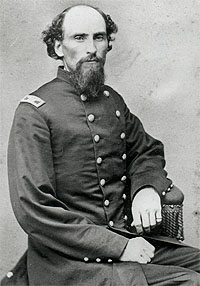Samuel J. Crawford facts for kids
Quick facts for kids
Samuel J. Crawford
|
|
|---|---|
 |
|
| 3rd Governor of Kansas | |
| In office January 9, 1865 – November 4, 1868 |
|
| Lieutenant | James McGrew Nehemiah Green |
| Preceded by | Thomas Carney |
| Succeeded by | Nehemiah Green |
| Personal details | |
| Born | April 10, 1835 Lawrence County, Indiana |
| Died | October 21, 1913 (aged 78) Topeka, Kansas |
| Political party | Republican |
| Spouse | Isabel Marshall Chase |
| Profession | attorney, politician, soldier, real estate |
| Military service | |
| Allegiance | United States |
| Branch/service | Union Army United States Army |
| Rank | Colonel Brevet Brigadier General |
| Commands | 2nd Kansas Colored Infantry Regiment 19th Kansas Cavalry Regiment |
| Battles/wars | American Civil War American Indian Wars |
Samuel Johnson Crawford (born April 10, 1835 – died October 21, 1913) was an important figure in Kansas history. He served as an officer in the Union Army during the American Civil War. Later, he became the third Governor of Kansas, serving from 1865 to 1868. He was also one of the first people to serve in the Kansas Legislature.
Contents
Early Life and Education
Samuel J. Crawford was born on April 10, 1835, in Lawrence County, Indiana. He grew up on a farm and went to school in Bedford, Indiana. He later studied law at Cincinnati College. His parents, William and Jane Crawford, moved to Indiana in 1815.
Moving to Kansas
Samuel J. Crawford arrived in Kansas Territory on March 1, 1859. He started his career as a lawyer in Garnett, Kansas. Soon after, he joined the Osawatomie Convention. This meeting helped create the Republican Party in Kansas.
In September 1859, he was chosen as a delegate for the Republican state convention in Topeka. This convention nominated state leaders under the new Wyandotte Constitution. In November 1859, he was elected to the first state Legislature. He helped set up the new state government.
Military Service in the Civil War
When the American Civil War began, Samuel Crawford left his job in the Legislature. He became a captain in the 2nd Kansas Infantry. He fought in the 1861 Southwest Missouri campaign. He was part of many battles, including the important Battle of Wilson's Creek.
In March 1862, Crawford was put in charge of Company A, 2nd Kansas Cavalry. Later, he led a group of soldiers called a battalion in the same regiment.
Battles and Leadership
With the 2nd Kansas Cavalry, he served with General James G. Blunt in Missouri, Arkansas, and Indian Territory. He fought in battles like Newtonia, Old Fort Wayne, and Prairie Grove. At Old Fort Wayne, he led his battalion in a charge that captured enemy cannons.
On March 12, 1863, he was given command of the entire 2nd Kansas Cavalry. He joined General Blunt at Fort Gibson for a trip south. This trip ended with the capture of Fort Smith, Arkansas. Colonel Crawford helped capture many prisoners, supplies, and Confederate money.
In November 1863, he became a colonel of the 2nd Kansas (Colored) Infantry. This regiment later became the 83rd U.S. Colored Troops. His regiment fought well in the Camden Expedition and the Battle of Jenkins' Ferry. In this battle, his troops helped capture three enemy cannons.
Becoming Governor of Kansas
While still serving in the army, Samuel Crawford was nominated to be governor of Kansas on September 8, 1864. He took a break from the army on October 1. However, when he arrived in Kansas, he learned about Price's Missouri Raid. Instead of campaigning, he joined General Samuel R. Curtis to help fight. For his brave actions, he was given the honorary rank of Brigadier General on March 13, 1865.
On November 8, 1864, he was elected governor. He officially became governor on January 9, 1865. On September 5, 1866, he was re-elected, becoming the first person to serve a second term as governor of Kansas.
Governor Crawford resigned on November 4, 1868. He left to lead the 19th Kansas Cavalry Regiment. This regiment joined the 7th United States Cavalry in a winter campaign.
Life After Governorship
After being governor, Crawford worked in the real estate business in Emporia, Kansas. In 1876, he moved to Topeka. He worked on getting money for Kansas from the United States government for school lands. Later, he moved to Washington, D.C., and worked as a lawyer there.
Crawford also wrote a book called Kansas in the '60s. This book shared a lot about what early Kansas was like.
On December 1, 1870, he helped create the Florence Town Company. This group of men learned where the Atchison, Topeka and Santa Fe Railway would cross the Cottonwood River. They decided to build a town there. He named the town, Florence, after his daughter.
Legacy
Crawford County, Kansas is named after Samuel J. Crawford. Many cities in Kansas also have streets named in his honor.

